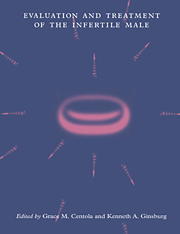Book contents
- Frontmatter
- Contents
- Preface
- List of contributors
- 1 Andrology
- 2 Sperm–egg interaction
- 3 Routine semen analysis
- 4 Computer-aided sperm analysis: a critical review
- 5 Antisperm antibodies: diagnosis and treatment
- 6 The sperm penetration assay
- 7 Intrauterine insemination for male factor
- 8 Processing human semen for insemination: comparison of methods
- 9 New assays for evaluating sperm function
- 10 Assisted reproductive technology for male factor infertility
- 11 Microinjection techniques for male infertility
- 12 Therapeutic donor insemination: screening, indications and technique
- 13 Endocrine assessment and hormone treatment of the infertile male
- 14 The urologic evaluation of the infertile male
- 15 Azoospermia: the diagnosis and treatment
- 16 White blood cells in semen and their impact on fertility
- 17 Psychological aspects of male infertility: lifting the shroud of shame
- 18 Evaluation of the female partner
- Index
8 - Processing human semen for insemination: comparison of methods
Published online by Cambridge University Press: 16 September 2009
- Frontmatter
- Contents
- Preface
- List of contributors
- 1 Andrology
- 2 Sperm–egg interaction
- 3 Routine semen analysis
- 4 Computer-aided sperm analysis: a critical review
- 5 Antisperm antibodies: diagnosis and treatment
- 6 The sperm penetration assay
- 7 Intrauterine insemination for male factor
- 8 Processing human semen for insemination: comparison of methods
- 9 New assays for evaluating sperm function
- 10 Assisted reproductive technology for male factor infertility
- 11 Microinjection techniques for male infertility
- 12 Therapeutic donor insemination: screening, indications and technique
- 13 Endocrine assessment and hormone treatment of the infertile male
- 14 The urologic evaluation of the infertile male
- 15 Azoospermia: the diagnosis and treatment
- 16 White blood cells in semen and their impact on fertility
- 17 Psychological aspects of male infertility: lifting the shroud of shame
- 18 Evaluation of the female partner
- Index
Summary
Introduction
The introduction of in vitro fertilization and other assisted reproductive technologies (ART) has provided the catalyst for the further development of techniques which isolate motile sperm. The goal of these sperm isolation procedures is the accumulation of a highly motile population of morphologically normal cells in a relatively small volume of medium. This sperm mixture can then be used for a number of different ART procedures. One such procedure, the most widely utilized in ART, is insemination using either the male partner's or donor sperm. The type of insemination performed is defined by the source of sperm, whether from partner or donor, and the site in the reproductive tract where the sperm are deposited. Other possible uses of washed sperm are insemination of oocytes in vitro. This procedure is usually used for patients who cannot or do not benefit from partner or donor insemination.
Intracervical insemination (ICI) has been one of the most widely used treatments for infertile patients. The indications for ICI are restricted to conditions where normal deposition of sperm cannot take place, such as hypospadias, impotence, or sexual dysfunction (vaginismus or dyspareunia), or donor insemination. Studies using fresh donor sperm have shown that couples undergoing ICI should experience pregnancy rates of 8–17% per ICI treatment cycle and approximately 60% of all couples should conceive after 6 months of treatment (Bradshaw et al., 1987).
ICI is performed intravaginally using either an unprocessed ejaculate or washed sperm. If the sperm are introduced at any point superior to the internal os of the cervix, it is considered intrauterine insemination (IUI).
- Type
- Chapter
- Information
- Evaluation and Treatment of the Infertile Male , pp. 89 - 107Publisher: Cambridge University PressPrint publication year: 1996
- 4
- Cited by

